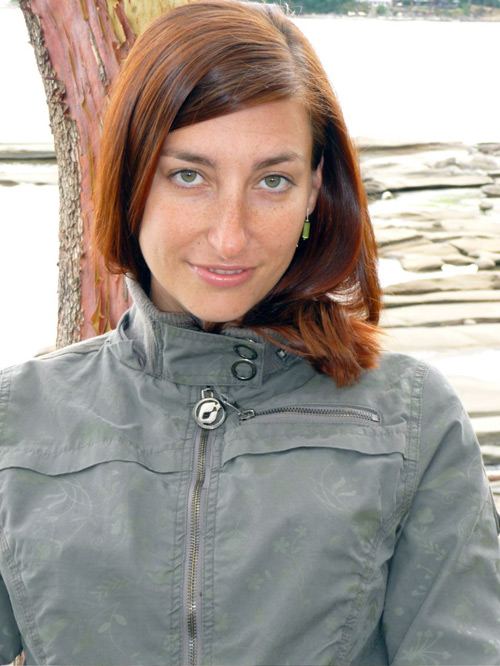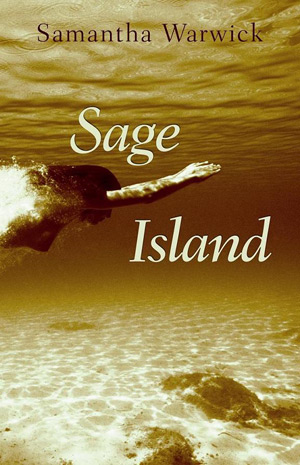|
TDR
Interview: Samantha Warwick
 Interview
by Jessica Westhead Interview
by Jessica Westhead
Samantha
Warwick lives and works in Calgary, and received her MFA in creative
writing from UBC. Her work has been broadcast on CBC Radio and has
appeared in litmags such as Geist, Event, Room, and echolocation.
She spent seven years coaching competitive swimming between 1997 and
2004, and has participated in long-distance open-water swim races in
British Columbia, California, and New York.
Sage Island
(Brindle & Glass, 2008) is Samantha’s debut novel. Set in
mid-1920s New York and Catalina Island, California, the story follows
the highs and lows of 19-year-old Savanna (Savi) Mason’s competitive
swimming career. Along the way, she contends with difficult
relationships, the sexism and classism of the flapper era, and her own
perfection-seeking self-doubt.
[November 2008]
See also www.samanthawarwick.com
*
JW: Among many other
things, Sage Island is about swimming, and drinking a lot of
booze. What inspired you to put them together in this book?
SW:
Actually, the swimming and drinking elements of the novel came about
independently; it wasn’t until I was leafing through the published
book, considering scenes for readings, that I noticed how much drinking
goes on. Prohibition was a time when people (at least those who could
get their hands on booze) drank twice as much as they might have had
there not been a rule telling them they couldn’t. But in keeping with
your question—I only became aware of the metaphorical implications and
relationship between swimming and drinking after the book was written. I
thought it was funny and somewhat apt because if you look up
"swim" in the dictionary, you’ll find a few definitions, the
first being: 1) to propel the body through water by working the arms
and legs; and 2) to experience a dizzy or confused feeling in the
head. I thought the definitions were funny, in part because Savi
(the protagonist) excels at both forms of "swimming."
 JW:
You’ve submerged your characters in the Prohibition era with 1920s
diction and lots of period details, including the satin crêpe dress
that Savanna wears to a fancy lunch, and the explosion of flares and
flash powder at a photo shoot. What was your research process like for
the story’s historical side? JW:
You’ve submerged your characters in the Prohibition era with 1920s
diction and lots of period details, including the satin crêpe dress
that Savanna wears to a fancy lunch, and the explosion of flares and
flash powder at a photo shoot. What was your research process like for
the story’s historical side?
SW:
I read 1920s literature voraciously. I also watched movies, both old
movies and contemporary movies depicting the 1920s. One of my professors
at UBC told me I needed to immerse so deeply into the era that the idea
of wearing pants should feel totally ridiculous.
JW: Despite Savi’s
incredible talent and drive, she can also be her own worst critic—she
berates herself for her real and perceived failures, and is often easily
swayed by other people’s opinions of her. While you were writing this
novel, did you have your own inner naysayer? And if so, were you able to
drown it?
SW:
I think there is something about the writing process that can bring out
the purest form of insecurity. I definitely had spells where I felt like
I could use a drink before noon. For me, the most difficult times were
when I had to re-immerse myself into the project after periods of being
away from it. Or when I had to prioritize/justify the time I needed to
properly write the book. Sometimes that meant asking for time off work,
sometimes it meant protecting my writing time from social temptations.
But once I was back in the text, the period, the story, and especially
into Savi’s voice—that’s when she would become autonomous again
and start taking off and doing things I hadn’t expected. That part is
the best, when time becomes fluid and you’re lost in this other world.
It was during these stretches that I was able to drown the challenging
thoughts.
JW: Who are some of
your writing influences? Are you reading anything especially delightful
right now?
SW:
I’ve been told it’s really cliché to answer this question with
Hemingway, but it’s the truth. Hemingway was and continues to be an
inspiration. I love the brevity of his writing and the way his scenes
feel so visceral without excessive description. My other favourite 1920s
writer is Dorothy Parker. I love her writing—she is one of the
funniest, most brilliant writers I have ever read. I quoted her to my
editor when we were working together: "This is not a novel
to be tossed aside lightly. It should be thrown with great force."
I love that—it was exactly how I was feeling about the book before I
handed the manuscript back to him. Contemporary writers who have
captured my imagination include Wayne Johnson, Keith Maillard, and Meg
Wolitzer, among others. Literary fiction aside, I recently picked up a
copy of The Female Brain by Louann Brizendine, M.D., while I was
travelling and I can’t put it down.
JW: Overall, what’s
been your experience so far with having your first book out in the
world? And are you working on any new projects these days?
SW:
At first I felt sick. For me, having a book released into the world has
been a massive lesson in letting go. But now that it’s out there and
people are reading it, I feel more at peace with the whole experience,
at peace with people having their own questions, interpretations, and
thoughts.
As to new projects, I’m
planning to revisit a skeletal manuscript I started two years ago—a
patchwork of ideas for a second novel that explores a young woman’s
journey as she is forced to reframe her core beliefs around sex. In the
spirit of what I said about Hemingway, I see my new protagonist as a
modern-day (and female) Jake Barnes, rambling around a city where (she
thinks) everyone takes sex for granted.
Check out Samantha online
at www.samanthawarwick.com
|